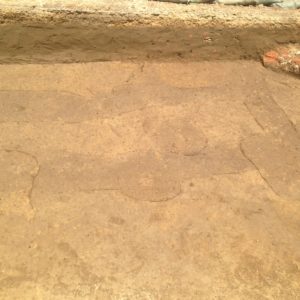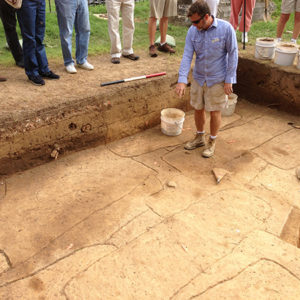This summer, archaeologists at Historic Jamestowne found 10 dark planting furrows extending eastward from the original 1607 James Fort and dating to the first months of the settlement.
About a foot and a half wide and spaced evenly apart, the shallow features are the earliest evidence of English planting found in the New World. This work was described by John Smith in 1607 as:
“What toile wee had, with so smal a power to guard our workmen adaies, watch al night, resist our enimies and effect our businesse, to relade the ships, cut downe trees, and prepare the ground to plant our corne, etc.”
Smith’s account and this newly-discovered archaeological evidence both reinforce the specific instructions the Virginia Company gave the first settlers: to divide the group into thirds, with one third building a fort and others to “prepar[e] your ground and sow . . . your corn and roots; . . .”
Archaeologists confirmed the early nature of the furrows by finding that a 1608 wall line trench cut through the furrow marks, demonstrating that the planting rows predate the 1608 palisade. The furrows discovered this summer seem to match furrows uncovered by the Jamestown Rediscovery team about a decade ago just outside the southeast bulwark of James Fort. All the furrows together would amount to about half an acre of planting.
“This isn’t the way they would have planted if they were in England with draft animals. This is the beginnings of New World agriculture, taking a hoe and digging a ditch,” said Jamestown Rediscovery Senior Staff Archaeologist David Givens.
There is some question what the English meant when they wrote that they planted “corn.” Bly Straube, Senior Archaeological Curator for the Jamestown Rediscovery Project, said “corn” to the English meant grain (wheat, barley, oats), and they had brought seeds of English grains with them to plant because the Virginia Company was curious as to how well English crops would do in the New World.
And the garden area may have included some tropical plants. Colonist Gabriel Archer (who was back in England in 1608) talked about how they brought pineapple from the West Indies, which was “set in our mould, which fostereth it and keeps it green,” according to Straube. Archer said other West Indian plants also did well: orange, cotton trees, potatoes, pumpkins and melons. “All our garden seeds that were carefully sown prosper well, yet we only digged the ground half a ____ deep, threw in the seeds at random carelessly, and scarce rak’d it.”
Hand-dug furrow agriculture was practiced in Virginia for centuries after 1607. Forensic evidence from later colonists shows the physical impact of this style of farming. The Smithsonian’s National Museum of Natural History said in its “Written in Bone” exhibit about colonists in the Chesapeake region that “Lower back strain was constant in hoeing soil to make hills for planting corn and tobacco, or weeding between the hills until the corn or tobacco grew tall enough to shade out weeds.” Such lifelong work led to herniated disks and vertebral stress fractures in the bones studied for the exhibit.
“This is the beginning of Southern agriculture. Agriculture—the growing of tobacco—saved the colony and set the economic pattern for the South for centuries,” Givens said.
“It’s remarkable that these furrows have survived, probably because they were in the churchyard and protected,” he said. “There is no later plowing here. It’s completely intact.”
Other early features were similarly protected. In mid-August a test of a feature just east of where the 1907 Memorial Church now stands showed a hole much deeper than would appear for a James Fort-period palisade post. Senior staff archaeologist Jamie May excavated the hole and found something more like a support for a gate or a storehouse from a very early date because the hole had only prehistoric and American Indian objects in the fill.
“This was filled very early and very rapidly. That’s why we think it is a post hole,” she said. “It’s shows the importance of testing the features like we do. This really looked like the perfect end of the palisade, but we tested it and it’s not. You’ve got to dig these things.”
The archaeologists are exploring another large post hole that may indicate a building or guard tower at the corner where two palisades meet.
This summer’s excavations in the churchyard of the 1907 Memorial Church have found about 70 feet of the palisade that framed the eastern expansion of James Fort, said Dr. William M. Kelso, head of archaeological research at Historic Jamestowne. The shape of this expansion also seems to be a mirror image of James Fort, where one angle of the triangle was 90 degrees and two were 45 degrees. So a bird’s eye view of the expanded fort might resemble a diamond shape, Kelso said.
During the excavations around the palisade extension, archaeologists found another fragment of a pipe with initials—perhaps part of the output of Robert Cotton, a tobacco pipe maker who came to Jamestown in 1608. Several years ago the Jamestown Rediscovery Project recovered unusual pipe fragments from a circa 1608-1610 well in James Fort; the fragments bore lettering that spelled the names of English politicians, military heroes and Virginia Company officers.
The initials of the fragment found this summer are “NH,” which could refer to gentleman Nicholas Holgrave, who was among the original settlers in 1607.
This pipe fragment, like other artifacts found in the churchyard area this summer, is in fill dirt taken from somewhere else. But where? The archaeologists have not yet found the location of Cotton’s pipe-making operation.
related images
- 1607 planting furrows east of James Fort (the two dark bands running left to right)
- Senior Staff Archaeologist Dave Givens pointing to the 1608 palisade extension
- Senior Staff Archaeologist Jamie May excavating an early James Fort post








